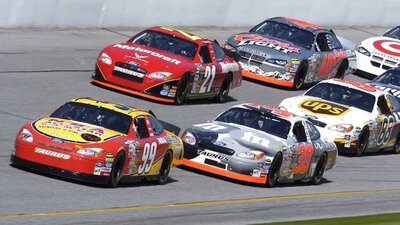Table of contents
What Is a Website Conversion?
Olha Diachuk, Creative Writer @ OWOX
A website conversion is an event in a web analytics system that marks the completion of a website goal. Goals vary depending on the aims and type of your website and business. They’re sometimes called desired actions.
Examples of website goals:
If you’re a new publisher with an online magazine, you might want people to subscribe to your articles.
If you’re the owner of an online supermarket, you probably want people to buy from you again and again.
Let’s learn how to use conversions to increase your profit!
What is a website conversion rate and how can you calculate it?
To start tracking your website’s conversion rate, you must first set up goal tracking and assign goals as conversions in a website analytics system like Google Analytics.
This service tracks conversions, collects information about visitors, and helps you understand who converts and what pages are better than others at getting people to perform desired actions.
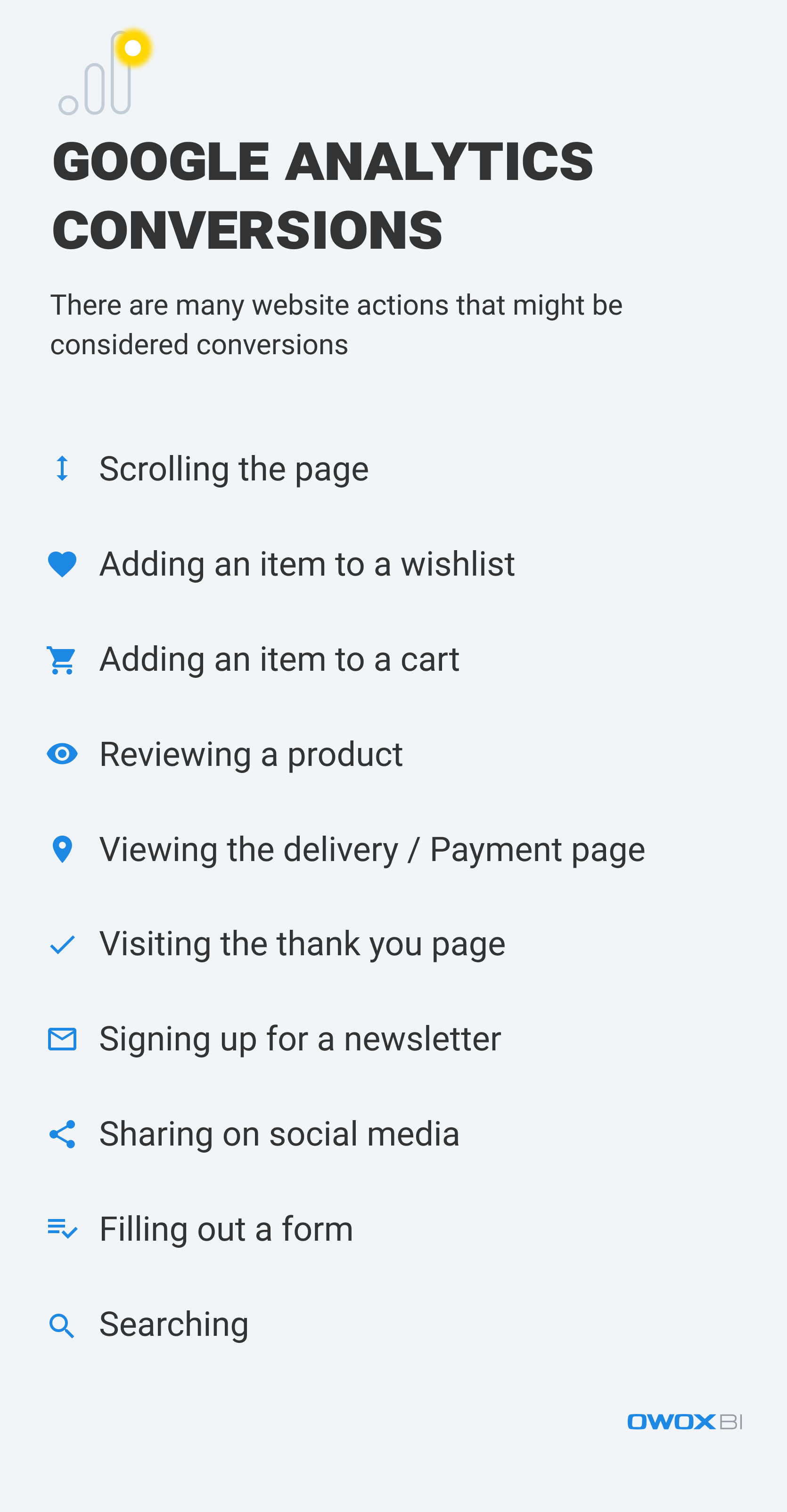
Marketing is all about making a business profitable. Conversions are a key indicator of whether marketing efforts are worth the investment.
The conversion rate indicates the percentage of users that have taken actions that are profitable for your business. It shows if your website is doing well with converting visitors into buyers or if it just lets them go away without purchasing or sharing their contact information.
So how do web analysts calculate the conversion rate?
Website conversion rate (CR) =
(Number of goal achievements / Number of users) × 100%
For example, the conversion rate for an online shop selling goods will be calculated as:
СR = (Number of purchases / Total number of users) × 100%
This calculation can be done automatically, but it’s essential for you to understand how it works. Each analytics system has its own rough edges that are easily avoidable if you understand the meaning of the metrics and possible analytical traps.
Let’s go from calculating to estimating!


What is a good/bad/normal website conversion rate?
What are good and bad conversion rates? The short answer is it depends. There’s no magic value. Rather, it’s a matter of opinion.
What you consider good and bad depends on a wide range of factors, and comparing your conversion rate to others without a proper approach might make you worry too much.
For example, say you have a new e-commerce store with handmade Japanese treats and your conversion event is landing on the thank you page after making a purchase. In this scenario, you can be quite happy with a 2–4% conversion rate, and a 0.5% change won’t mean all that much.
On the other hand, if you’re a mature retailer like Amazon with millions of visitors, a decrease of 0.5% will lead to losses in the millions of dollars.
These examples show us that a "good" CR is relative.
While exploring the market and building relationships with customers, each business starts to gather best practices based on what works well for them. A conversion rate can only be seen as good or bad in comparison with others. You can make this comparison through benchmarking, competitor analysis, etc.
The most important comparison to make is to your own conversion rate for a previous period. You have to grow at your own pace, maintaining profitability and optimizing your spending.
Let’s have a brief look at what influences the conversion rate:
- Technical issues
- The quality of a landing page: loading speed, intuitiveness of design, convenience of navigation and menus, reliability, security certificates
- Other characteristics: device, platform, location
- Traffic source (where your customers come from)
- Buyer’s segment or cohort, buyer’s habits, and level of brand awareness
- Call-to-action: promotion, position, design, and text
- Tone of voice, brand communications, reliability
All of these factors form a complicated corridor of webpages and actions along the customer journey. Your first task is to make this journey as smooth as possible. And if your CR is low and you want to increase your website performance, each item in this list offers a possibility for you to improve your conversion rate.
You can get an idea of a normal conversion rate in benchmark reports for your industry and based on the approximate type and size of your business. Even data on your direct competitor’s conversion rate might be a motivational punch for some time. But again, neither benchmarks nor competitors’ CRs can be your baseline, as each business’s effectiveness is calculated differently; a 0.5% difference can be a devastating loss for one business and totally okay for another.
By the way, learn how and why your competitors can influence your conversion rate with their pricing to know how you can control this situation.
To find a canonical CR for your business, you have to rely on other metrics you have: CAC, LTV, gross margin. You should always calculate your CR in connection with these metrics.
The process of improving your conversion rate is never-ending; whenever you reach the benchmark for your local market, you can move further to the country level and even global benchmarks. Here’s a list of CR benchmarks for some of the most popular industries:
Everything you do to improve your conversion rate is called conversion rate optimization. Let’s see how to set up a chain of micro and macro goals to measure your conversion rate realistically.
Goals in Google Analytics
Setting up goals is one of the most important parts of setting up your Google Analytics account. You can find goal statistics in the side menu of Google Analytics, under Conversions –> Goals.
To set up a goal, you need to set up your Google Analytics account and follow the instructions after choosing what kind of goal you want to establish:
- Visiting certain URLs
- Spending a certain amount of time on a page
- Going deeper on your website, measured by pages per visit
- Completing events, such as clicking on widgets or spending a certain amount of time watching videos
As you can see, there are plenty of ways to set up your conversions in the form of goals.
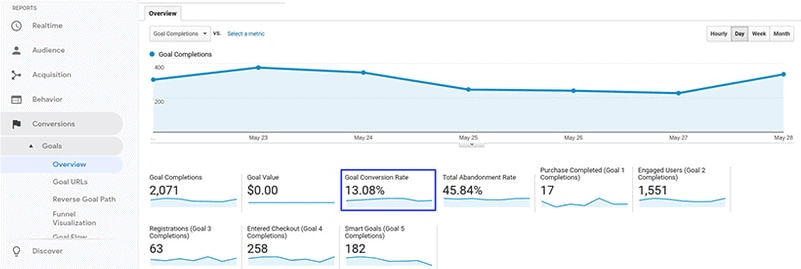
In the Goal URLs tab in Google Analytics, you can find a list of URLs marked as end URLs for goal completion. Here’s the place where you can see approximate goal values according to the number of completed goals. And it’s obvious that all goals can’t have the same value.
For example, for an online store, the goal of subscriptions is less important than the goal of purchases.
If you sell products, your macro goal will be to ensure that the visitor makes a purchase. But there can be other micro goals the visitor must complete before fulfilling the macro goal.
For example, a visitor must enter the website, choose a product, add it to the cart, proceed to checkout, enter payment and delivery information, and only then make a purchase.
Micro goals are essential for marketers to investigate because they hide the reasons why people leave and don’t convert into customers.
The reverse goal path will show you what pages appeared before the goal was completed. It’s useful to investigate customer behavior and understand what’s going as planned and what isn’t.
Funnel visualization describes the same thing as goal flow, but from a different point of view. You can track the process of customer conversion from the landing page to the last goal completion and clearly see the percentage of visitors who jump to other pages.
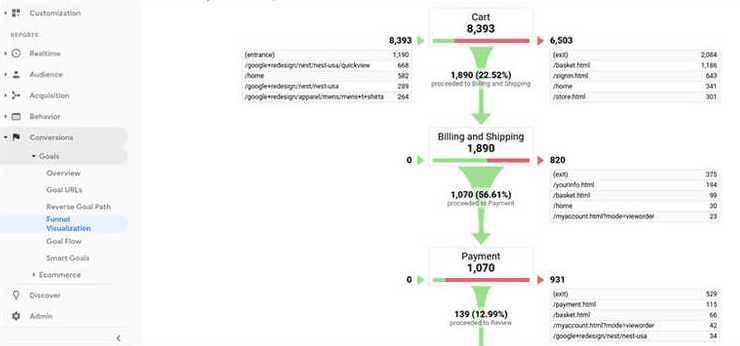
Setting Smart Goals in Google Analytics might be interesting for those who have more than 500 clicks sent from AdWords to Google Analytics in the past 30 days. Don’t miss the chance to track your metrics with more precise tools!
Establishing goals is part of setting up end-to-end analytics. The sooner you get acquainted with the principles of this kind of analytics, the better. Now, let’s reveal the flaws in the Google Analytics goal and conversion tracking system.
Setting up goals is a must for any kind of business. It even has a disciplinary effect on your business and marketing.
When you set up the goal flow, you set the golden standard for conversion behavior, when a visitor runs smoothly through each stage of the conversion funnel right to the purchase or another desirable action. And after looking at bottlenecks along this path, you’ll find the insights you need to grow.
Conversion rate traps in Google Analytics
The “medium” and “average” CRs displayed in the Conversions –> Goals –> Overview tab in GA mean nothing.
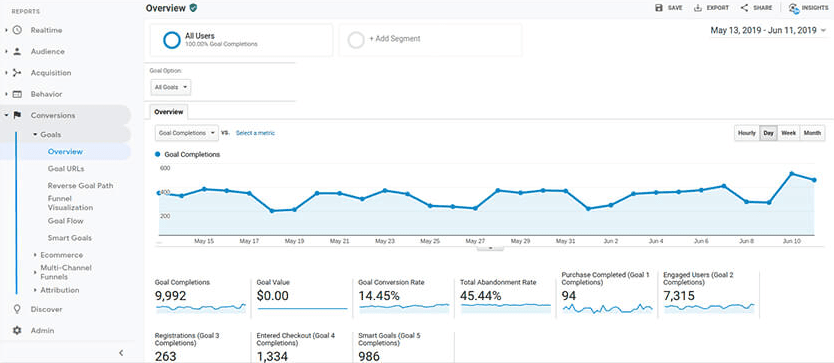
It’s a typical trap of statistics, where the standard average formula gives a number that’s just the result of a mathematical calculation but isn’t insightful. Goals may have different degrees of importance, the values of conversions may be different, and averaging them is pointless. It’s like comparing dry with white.
You should look at the conversion rate in each typical set of arrangements. The best practice is to analyze the conversion rate within certain dimensions. Analyzing your CR too generally leads nowhere. As does not analyzing at all.
The conversion rate isn’t the holy grail of website analytics, but CR and e-commerce metrics are more closely connected to actual profit than other metrics. Just track CR as one of the metrics indicating your company’s growth and the efficiency of your website optimization efforts.
To know if things are getting better or worse, track how CR changes in real time, try to forecast it, and include it in your checklist of sales plan performance. As soon as you calculate how much a 0.1% drop in CR costs you, you’ll understand the importance of this metric. And you’ll see where your customer journey funnel is leaking.
To know how your channels and marketing efforts influence how customers pass through your funnel, you should know what attribution is and how to choose an attribution model for your business.
Attribution traps for conversion rate
Attribution is an instrument that helps you understand the impact of each channel on your conversions by modelling the value distribution for each step in the funnel.
The typical scope of Google Analytics attribution models are quite narrow and don’t even include all the steps you need. You can find attribution models that help you understand what channels bring you the most profitable conversions.
But typically, they make things even more complicated, leaving some channels under or overestimated because of logical limits and flaws in models. This leads to wasting money on inefficient ad campaigns or mistaken ideas about the efficiency of the whole company’s marketing.
To avoid this situation, we created OWOX BI Attribution, a product that helps you distribute values using a funnel-like attribution model with proven efficiency. It’s the most viable alternative to Google Analytics models, considering their weaknesses and the growing needs of businesses to correctly track all of a customer’s steps that lead to a conversion. If you’re ready to test OWOX BI Attribution, try it for free now:
Any kind of traffic changes may decrease or increase the conversion rate, as can changes in your advertising strategy or technical issues. Let’s see what to do to make conversion rates better.
Conversion rate optimization
Conversion rate optimization (CRO) helps your customers convert more easily and thus increases the conversion rate. It’s used by CRO developers, UX designers, and marketers to improve the website and the customer journey. Here’s what conversion rate optimization typically entails.
Technical improvements
Technical issues are always the most important for CRO. Start with optimizing the load speed, debugging JavaScript errors, and testing all CTAs and landing pages. Your conversion rate will never increase if pages with goals contain errors and send the wrong responses. And this will be mirrored in your profits.
Also, a website’s security, cookies, and personal data policies matter more to website visitors today than they did five years ago. Show people that you care about the safety of their data and use only reliable services, especially for payment. An SSL certificate is a must. Customers view a store as reliable if it has an https:// address.
Design
An attractive and comfortable website is no longer a luxury but a requirement. Try to improve your brand and invent new graphical elements to refresh your website’s look. This will increase interest and make the path to conversion more pleasant. More tips and tricks:
- Tell a story about your products or services with the help of design. Show how they work and allow people to feel the product. Hire a UI/UX consultant or designer to investigate your website and show you room for improvement.
- Put the right CTA in the right place. If you want people to answer your CTAs, make them clear and visible. Don’t mess with hundreds of them. Choose those that are explicitly connected with conversions.
- Help people to solve a problem. Remove everything that might lead them astray.
- Better online merchandising is necessary for your conversion success. What products will be presented at the top and why? How will people react if products have low-quality images or are poorly described? All of these things will influence a person’s desire to buy or ask for your services, thus influencing the conversion rate.
Less is more in modern web design. Don’t try to add too much or strike your customer with neon-like pop-ups and red buttons! It will harm your conversion rate.
Content
Content is king, so make it understandable. All CTAs should help people take a desired action. Make sure that your SEO-optimized articles are useful; find content that doesn’t work and improve it constantly until it becomes fruitful and leads to conversions.
Your style also matters in every word on your website. Don’t be shy to get closer to your client. Remember that even a Buy Now button may be more attractive if it’s adapted to the context of your website. If you sell candies, a Buy Now, Sweetie button might work better than a simple Buy Now.
Remarketing
CRO with the help of remarketing is part of healthy marketing. Everybody knows that getting a customer to return is cheaper than obtaining a new one. The SEMrush Sales Funnel optimization approach will help you make the remarketing process seamless.
Money and delivery
Make your payment and shipment process as easy as possible. Each second of waiting and each additional checkout page leads to lost customers and decreases your CR. Customers want to save time, understand what’s going on, and rely on your service.
Dos and don’t list in a way to personally perfect CR
You may find your own recipe for a 400% conversion rate, but we advise you to start with the following principles:
Dos:
- Choose KPIs to control the situation. Starting with the CR, get in the habit of monitoring and planning CRO, working over bottlenecks in the funnel, and smoothing the goal flow.
- Care about the people you’re working for — your end customers. Consider their buying habits and preferences at each stage of website improvement.
- Care about the services you’re adding to your website. Try to set them up to exclude misleading analytics and data loss. Use OWOX BI to feel totally secure about your data.
- Care about your company’s communications beyond the website: on social media, on referral platforms, etc. Get good reviews, get mentions by trend leaders, and collect feedback. This will help you keep your traffic fresh and your product trustworthy.
Don’ts:
- Don’t make conversion a main KPI for your business. Conversion is important, but only in complex analysis with other metrics. Get a sound view on the conversion rate.
- Don’t misunderstand CRO. Changing the color of buttons isn’t a CRO process. Stop it and understand what really distracts people from converting on your website.
- Don’t forget to update goals in Google Analytics if your website changes a lot in a technical way or if you change the checkout, delivery, or payment pages.
To learn more about conversions, subscribe to our secret newsletters, featuring trendy news and tips and tricks for marketing analytics.
FAQ
-
What does Conversion Rate Optimization entail?
CRO involves making your website more user-friendly to encourage more visitors to take the desired actions, thus improving your conversion rate. It includes technical improvements, design updates, content enhancement, and optimizing the payment and delivery process. -
What is a Good Website Conversion Rate?
A good conversion rate is relative and depends on various factors including industry, type of business, and specific goals. Benchmarking against industry standards and past performance can provide insights into what a good rate is for a particular website -
How is the website conversion rate (CR) calculated?
The conversion rate is calculated by dividing the number of goal achievements by the total number of visitors and multiplying by 100%.

